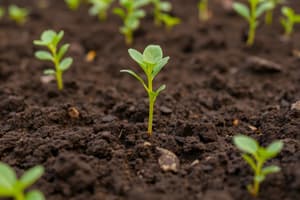Podcast
Questions and Answers
Which component of soil contributes to improving soil structure and fertility?
Which component of soil contributes to improving soil structure and fertility?
- Water
- Air
- Organic Matter (correct)
- Minerals
Clay soil has poor water retention.
Clay soil has poor water retention.
False (B)
What are the four main components of soil?
What are the four main components of soil?
Minerals, Organic Matter, Water, Air
The ability of soil to hold and exchange positively charged ions is known as __________.
The ability of soil to hold and exchange positively charged ions is known as __________.
Match the soil types with their characteristics:
Match the soil types with their characteristics:
Which soil management practice involves alternating crops to improve soil health?
Which soil management practice involves alternating crops to improve soil health?
Soil erosion can only occur due to water.
Soil erosion can only occur due to water.
What is the primary influence of climate on soil formation?
What is the primary influence of climate on soil formation?
Flashcards are hidden until you start studying
Study Notes
Soil Science
-
Definition: Study of soil as a natural resource, including its formation, classification, and mapping.
-
Components of Soil:
- Minerals: Particles derived from weathered rocks; essential for plant nutrition.
- Organic Matter: Decomposed plant and animal residues; improves soil structure and fertility.
- Water: Vital for plant growth; affects soil texture and nutrient availability.
- Air: Provides oxygen for microbial activity; important for root respiration.
-
Soil Formation:
- Parent Material: The original rock or sediment from which soil develops.
- Climate: Influences weathering rates and organic activity.
- Topography: Affects drainage and erosion, impacting soil depth and quality.
- Biological Factors: Organisms, including plants, animals, and microbes, contribute to soil development.
-
Soil Properties:
- Texture: Proportions of sand, silt, and clay; affects water retention and drainage.
- Structure: Arrangement of soil particles into aggregates; influences aeration and root penetration.
- pH Levels: Measure of acidity or alkalinity; affects nutrient availability and microbial activity.
- Cation Exchange Capacity (CEC): Ability of soil to hold and exchange positively charged ions; key for nutrient supply.
-
Soil Types:
- Clay: Fine particles, good water retention, poor drainage.
- Silt: Medium particles, holds moisture and nutrients well.
- Sand: Coarse particles, good drainage, poor nutrient retention.
- Loam: Balanced mixture of sand, silt, and clay; ideal for agriculture.
-
Soil Management Practices:
- Crop Rotation: Alternating crops to improve soil health and reduce pests/diseases.
- Cover Cropping: Planting crops during off-seasons to prevent erosion and enhance soil fertility.
- Conservation Tillage: Reducing plowing intensity to maintain soil structure and moisture.
- Soil Amendments: Adding organic matter, lime, or fertilizers to improve soil quality.
-
Soil Erosion:
- Caused by water, wind, and human activities; leads to loss of fertile topsoil.
- Mitigation strategies include contour farming, terracing, and maintaining vegetation cover.
-
Importance of Soil Health:
- Critical for food production and ecosystem sustainability.
- Supports biodiversity and regulates water cycles.
Soil Science Definition
- Soil science is the study of soil as a natural resource, encompassing its formation, categorization, and mapping.
Soil Components
- Minerals: These are particles derived from weathered rocks and are crucial for providing nutrients to plants.
- Organic Matter: This is comprised of decomposed plant and animal residues, acting as a beneficial component for soil structure and fertility.
- Water: Essential for plant growth, water affects soil's texture and its ability to provide nutrients.
- Air: Providing oxygen for microbial activity, air is vital for root respiration.
Soil Formation
- Parent Material: The original bedrock or sediment upon which soil formation occurs.
- Climate: Factors like temperature and precipitation influence weathering rates and levels of organic activity.
- Topography: This affects drainage and erosion, impacting soil depth and overall quality.
- Biological Factors: Living organisms, including plants, animals, and microbes, play a role in soil development.
Soil Properties
- Texture: Determines the proportions of sand, silt, and clay, which in turn directly influences water retention and drainage, impacting soil health.
- Structure: The arrangement of soil particles into aggregates, affecting aeration and the ease of root penetration.
- pH Levels: A measure of soil acidity or alkalinity, it has a direct impact on nutrient availability and microbial activity.
- Cation Exchange Capacity (CEC): The soil's ability to hold and exchange positively charged ions, essential for nutrient supply.
Soil Types
- Clay: Composed of fine particles, clay has the benefit of good water retention, but its drawbacks include poor drainage.
- Silt: With medium-sized particles, silt is well-suited to hold moisture and nutrients.
- Sand: Composed of coarse particles, sand exhibits good drainage but is deficient in nutrient retention.
- Loam: A balanced blend of sand, silt, and clay, loam represents the ideal soil type for agricultural purposes.
Soil Management Practices
- Crop Rotation: This practice of alternating crops enhances soil health and reduces the negative effects of pests and diseases.
- Cover Cropping: Planting crops during non-growing seasons helps prevent erosion and boost soil fertility.
- Conservation Tillage: By reducing plowing intensity, conservation tillage protects soil structure and maintains moisture.
- Soil Amendments: Adding organic matter, lime, or fertilizers directly improves soil quality.
Soil Erosion
- Soil erosion is caused by water, wind, and human activities leading to the loss of fertile topsoil.
- Mitigation methods include practices like contour farming, terracing, and maintaining vegetation cover.
Importance of Soil Health
- Healthy soil is fundamental for food production and overall ecosystem sustainability.
- It supports biodiversity and regulates water cycles, playing a vital role in the natural world.
Studying That Suits You
Use AI to generate personalized quizzes and flashcards to suit your learning preferences.




